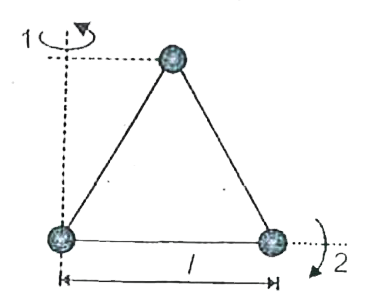Three mass points each of mass m are placed at the vertices of an equilateral triangle of side 1. What is the gravitational field and potential due to the three masses at the centroid of the triangle ?
To solve the problem of finding the gravitational field and potential at the centroid of an equilateral triangle formed by three point masses, we can follow these steps:
Step 1: Understand the Geometry
We have three point masses, each of mass m, located at the vertices A, B, and C of an equilateral triangle with side length L=1. The centroid D of the triangle is the point where we want to find the gravitational field and potential.
Step 2: Calculate the Distance from the Centroid to a Vertex
The distance from the centroid D to any vertex (say A) can be calculated using the properties of the triangle. The centroid divides the median in a 2:1 ratio. The length of the median m of an equilateral triangle can be calculated using the formula:
m=√32L
For our triangle with L=1:
m=√32⋅1=√32
The distance from the centroid D to vertex A (denoted as dA) is:
dA=23m=23⋅√32=√33
Step 3: Calculate the Gravitational Potential at the Centroid
The gravitational potential V due to a point mass m at a distance r is given by:
V=−Gmr
For the mass at vertex A:
VA=−GmdA=−Gm√33=−3Gm√3
Since the distances to all three masses are the same, the potential contributions from masses at B and C are the same:
VB=VC=−3Gm√3
Thus, the total gravitational potential V at the centroid D is:
V=VA+VB+VC=3(−3Gm√3)=−9Gm√3=−3√3Gm
Step 4: Calculate the Gravitational Field at the Centroid
The gravitational field E due to a point mass m at a distance r is given by:
E=Gmr2
For the mass at vertex A:
EA=Gmd2A=Gm(√33)2=Gm39=3Gm
The gravitational fields due to the masses at points B and C are equal in magnitude and directed towards their respective masses.
Step 5: Vector Addition of Gravitational Fields
The gravitational fields EA, EB, and EC form angles of 120∘ with each other. Since they are symmetrically placed, the net gravitational field at the centroid can be calculated using vector addition.
By symmetry, the horizontal components of the fields will cancel out, while the vertical components will add up to zero. Therefore, the net gravitational field E at the centroid is:
E=EA+EB+EC=0
Final Results
- The gravitational potential at the centroid D is:
V=−3√3Gm
- The gravitational field at the centroid D is:
E=0
We have three point masses, each of mass m, located at the vertices A, B, and C of an equilateral triangle with side length L=1. The centroid D of the triangle is the point where we want to find the gravitational field and potential.
The distance from the centroid D to any vertex (say A) can be calculated using the properties of the triangle. The centroid divides the median in a 2:1 ratio. The length of the median m of an equilateral triangle can be calculated using the formula:
The gravitational potential V due to a point mass m at a distance r is given by:
The gravitational field E due to a point mass m at a distance r is given by:
The gravitational fields EA, EB, and EC form angles of 120∘ with each other. Since they are symmetrically placed, the net gravitational field at the centroid can be calculated using vector addition.
- The gravitational potential at the centroid D is:
Topper's Solved these Questions
- GRAVITATIONBOOK - ICSECHAPTER - GRAVITATIONEXERCISE - CONCEPTUAL SHORT ANSWER QUESTIONS WITH ANSWERS
22 Videos
- GRAVITATIONBOOK - ICSECHAPTER - GRAVITATIONEXERCISE - LONG ANSWER QUESTIONS
13 Videos
- GRAVITATIONBOOK - ICSECHAPTER - GRAVITATIONEXERCISE - FROM THE HUBBLE TELESCOP
2 Videos
- FRICTIONBOOK - ICSECHAPTER - FRICTIONEXERCISE - Selected problems
30 Videos
- INTERNAL ENERGY BOOK - ICSECHAPTER - INTERNAL ENERGY EXERCISE - SELECTED PROBLEMS (FROM HEAT ENGINES)
21 Videos
Similar Questions
Three mass points each of mass m are placed at the vertices of an equilateral tringale of side l. What is the gravitational field and potential due to three masses at the centroid of the triangle ?
View SolutionThree identical point objects each of mass m are placed at the vertices of an equilateral triange of side l. What is the gravitational potential at the centre of the equilateral triangle due to the point masses?
View Solution
Knowledge Check
Three masses each of mass m are palced at the vertices of an equilateral triangles ABC of side l as shown in figure. The force acting on a mass 2m placed at the centroid O of the triangle is
 AzeroB3Gm2l2C5Gm2l2D7Gm2l2
AzeroB3Gm2l2C5Gm2l2D7Gm2l2
Three particles each of mass m are kept at vertices of an equilateral triangle of side L. The gravitational field at centre due to these particle is
View SolutionThree point masses 'm' each are placed at the three vertices of an equilateral traingle of side 'a'. Find net gravitational force on any point mass.
View SolutionThree equal masses of 1 kg each are placed at the vertices of an equilateral triangle of side 1 m, then the gravitational force on one of the masses due to other masses is (approx.)
View SolutionThree particle each of mass m are placed at the corners of equilateral triangle of side l

Which of the following is/are correct ?
View SolutionThree point charges q are placed at three vertices of an equilateral triangle of side a. Find magnitude of electric force on any charge due to the other two.
View SolutionThree masses 3, 4 and 5 kg are placed at the centre of an equiliteral triangle of 1 m sides. Locate its centre of mass.
View SolutionThree masses of 1 kg each are kept at the vertices of an equilateral triangle of side 3 m. What is the force acting on a point mass of 5 kg placed at its centroid ?
View Solution
